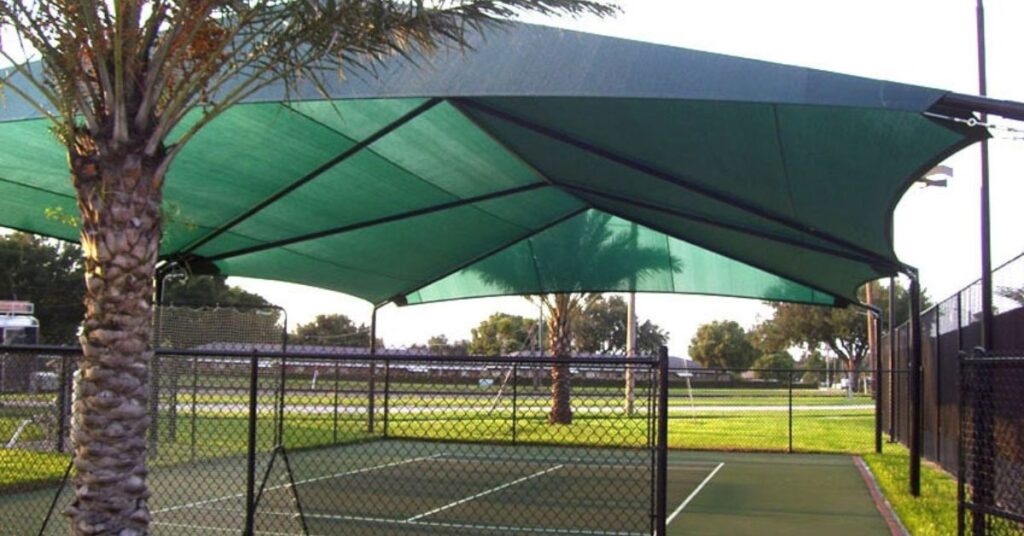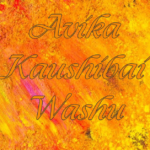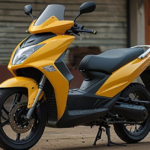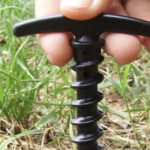Playing tennis is a thrilling and engaging activity that pushes both the mind and body to perform at their best. However, prolonged exposure to the sun can turn an otherwise enjoyable match into an exhausting experience, potentially affecting player performance and comfort. This is where tennis court shade structures come in, providing essential protection from harmful UV rays and creating a more pleasant environment for players and spectators alike.
In this comprehensive guide, we will explore the various types of tennis court shade structures, the benefits they offer, key considerations when choosing one, and how they enhance the overall tennis experience. Whether you’re a player, coach, or facility manager, understanding the value of shade structures can help you decide to improve your tennis court.
What Are Tennis Court Shade Structures?
Tennis court shade structures are specially designed coverings installed around or near tennis courts to protect from the sun’s intense heat and harmful ultraviolet (UV) rays. They can take various forms, including canopies, awnings, and pergolas, and are made from durable materials that are capable of withstanding outdoor conditions over time.
These structures are typically used to offer shade to players during breaks, protect spectators from the sun while watching a match, or even provide shelter for officials and equipment. They are increasingly becoming a common feature on tennis courts worldwide, particularly in regions with hot, sunny climates.
Why Tennis Courts Need Shade Structures
Protection from Harmful UV Radiation
One of the primary reasons for installing shade structures on tennis courts is to shield players and spectators from the harmful effects of UV radiation. Prolonged exposure to UV rays can lead to sunburn, skin aging, and even skin cancer. For tennis players who spend hours on the court, these risks are heightened, especially during peak sun hours.
A well-designed shade structure can block up to 90% of harmful UV rays, ensuring that players and spectators are adequately protected while enjoying the game. This also encourages longer play sessions without the risk of overexposure to the sun.
Check Also: Lansdale Bike Night 2024
Enhancing Player Comfort and Performance
Tennis is a physically demanding sport, and playing under the hot sun can lead to dehydration, heat exhaustion, and fatigue. Shade structures help reduce the intensity of the sun’s heat, offering players a cool spot to rest during breaks. This can lead to better performance on the court, as players are less likely to become overheated or fatigued during long matches.
For spectators, shade structures provide a comfortable space to watch the game without having to endure direct sunlight. This can significantly enhance their overall experience, making them more likely to attend future matches and events.
Protecting Equipment and Infrastructure
In addition to protecting people, shade structures also help protect tennis court surfaces and equipment from the damaging effects of prolonged sun exposure. UV radiation and heat can cause court surfaces to deteriorate over time, leading to cracks and fading. Shade structures can extend the lifespan of the court surface by reducing exposure to the elements.
Similarly, tennis equipment such as benches, net posts, and scoreboards can benefit from the added protection of shade. This not only helps preserve their appearance but also reduces the need for frequent repairs or replacements, saving money in the long run.
Types of Tennis Court Shade Structures
Several types of shade structures can be installed on tennis courts, each with its own unique advantages and aesthetic appeal. The right choice will depend on the specific needs of the court, its location, and the preferences of the facility owner or manager.
1. Cantilever Shade Structures
Cantilever shade structures are among the most popular options for tennis courts. These structures feature a single column or post that supports an extended roof or canopy, providing shade without obstructing movement or sightlines. Cantilever designs are ideal for covering areas around the perimeter of the court, such as benches, spectator seating, or walkways.
Advantages:
- Clear, unobstructed space beneath the canopy
- Sleek and modern design
- Durable and long-lasting
2. Hip Roof Shade Structures
Hip roof shade structures have a classic, symmetrical design with four sloping sides that meet at the top. These structures are often used for larger coverage areas and are commonly found in outdoor sports facilities, including tennis courts. The hip roof design provides excellent stability and wind resistance, making it a great choice for areas with unpredictable weather.
Advantages:
- Wide coverage area
- Strong and wind-resistant design
- Versatile and aesthetically pleasing
3. Tensioned Fabric Structures
Tensioned fabric shade structures are lightweight, flexible, and often feature a modern, futuristic design. The fabric is stretched tightly over a frame, creating a sleek and smooth appearance. These structures are highly customizable and can be designed to fit specific areas of the tennis court, such as player benches or spectator seating.
Advantages:
- Lightweight and flexible design
- Highly customizable
- Contemporary and attractive look
4. Shade Sails
Shade sails are triangular or rectangular pieces of fabric that are tensioned between several posts or anchor points. This type of structure is highly customizable and can be arranged in a variety of configurations to provide shade in specific areas of the court. Shade sails are a cost-effective option and are easy to install and maintain.
Advantages:
- Affordable and easy to install
- Versatile and customizable
- Modern and stylish design
5. Freestanding Umbrellas
Freestanding umbrellas are a simple and portable solution for providing shade on tennis courts. These large umbrellas can be placed around the court to create shaded areas for players, spectators, or officials. While not as permanent as other structures, freestanding umbrellas offer flexibility and can be moved as needed.
Advantages:
- Portable and easy to move
- Quick setup and removal
- Affordable option
Key Considerations When Choosing a Tennis Court Shade Structure
Selecting the right shade structure for your tennis court requires careful consideration of several factors. Here are some key aspects to keep in mind:
1. Material Quality
The quality of the materials used in the shade structure is critical to its durability and effectiveness. High-strength steel frames and commercial-grade HDPE (High-Density Polyethylene) shade fabric are often the best choices for tennis court shade structures. These materials are designed to withstand outdoor elements, including wind, rain, and UV exposure.
Ensure that the fabric used for the canopy or sail is UV-resistant and has a high shading factor to provide maximum protection from the sun.
2. Size and Coverage Area
Consider the size of the area that needs to be shaded. Whether you’re covering spectator seating, player benches, or other areas around the court, the shade structure should provide sufficient coverage to protect everyone from the sun. Larger structures, such as hip roofs or cantilever canopies, are ideal for covering wide areas, while smaller options like shade sails or umbrellas may be suitable for more localized coverage.
3. Aesthetic Appeal
While functionality is important, the appearance of the shade structure should also complement the overall design of the tennis facility. Many shade structures come in a variety of colors, shapes, and styles, allowing you to choose an option that enhances the aesthetics of the court. Tensioned fabric structures and shade sails, for example, often offer a modern and stylish look.
4. Weather Conditions
Consider the local climate and weather conditions when selecting a shade structure. Areas with high winds or frequent storms may require more robust structures with reinforced frames and secure anchoring systems. Hip roof and cantilever structures tend to offer better wind resistance compared to lighter options like freestanding umbrellas.
5. Budget
Shade structures come in various price points, depending on their size, materials, and design complexity. It’s important to set a budget and determine which type of structure fits within your financial constraints. While shade sails and freestanding umbrellas are more affordable, larger and more permanent structures, such as hip roofs or cantilevers, may offer better long-term value.
Installation and Maintenance
Installation Process
Experienced professionals should carry out the installation of a tennis court shade structure to ensure proper setup and safety. The installation process typically involves the following steps:
- Site Assessment: A thorough assessment of the site is conducted to determine the best location for the shade structure. This includes measuring the area, evaluating sun exposure, and identifying any potential obstacles.
- Foundation Preparation: Depending on the type of shade structure, a foundation may need to be prepared. This often involves pouring concrete footings to anchor the structure securely in place.
- Frame Assembly: The frame of the shade structure is assembled and anchored to the foundation. This step requires precision to ensure that the structure is level and stable.
- Canopy or Sail Installation: Once the frame is in place, the canopy or sail is attached and tensioned to create a tight, smooth surface that provides optimal shade coverage.
Maintenance Requirements
Regular maintenance is essential to ensure that the shade structure remains in good condition and continues to provide effective protection from the sun. Here are some common maintenance tasks:
- Cleaning: The shade fabric should be cleaned periodically to remove dirt, debris, and bird droppings. This can be done using a mild soap solution and a soft brush.
- Inspections: Conduct regular inspections of the frame, fabric, and anchor points to check for signs of wear, corrosion, or damage. Prompt repairs should be made if any issues are identified.
- Re-tensioning: If the fabric becomes loose over time, it may need to be re-tensioned to maintain its shape and effectiveness.
- Weather Protection: In regions with extreme weather conditions, it may be necessary to remove or cover the shade structure during storms or winter months to prevent damage.
Benefits of Tennis Court Shade Structures
Improved Player Health and Safety
One of the most significant benefits of tennis court shade structures is the protection they offer against harmful UV rays. By blocking up to 90% of UV radiation, these structures help reduce the risk of sunburn, skin cancer, and other sun-related health issues.
Additionally, shade structures contribute to player safety by preventing heat-related illnesses such as dehydration and heat exhaustion. Players can take breaks in shaded areas to cool down and hydrate, reducing the risk of overheating.
Increased Player and Spectator Comfort
Shade structures create a more comfortable environment for both players and spectators. By providing relief from the sun’s heat, these structures allow players to focus on their performance without being distracted by the discomfort of intense sunlight. Spectators can enjoy watching matches in comfort, leading to a more enjoyable experience for everyone.
Extended Court Usage
In hot climates, the lack of shade can limit the amount of time a tennis court is usable during the day. With shade structures in place, courts can be used for longer periods, even during the hottest parts of the day. This increased usability can lead to more matches, tournaments, and practice sessions, making the court a more valuable asset for the facility.
Enhanced Aesthetic Appeal
Well-designed shade structures can enhance the overall look of a tennis court and surrounding facilities. With a variety of styles, colors, and materials to choose from, shade structures can be customized to match the aesthetics of the court and its environment.
Long-Term Investment
While shade structures require an initial investment, they offer long-term value by protecting the court, equipment, and players from the damaging effects of the sun. Over time, this can lead to reduced maintenance costs and longer-lasting court surfaces and equipment, making the investment worthwhile.
Conclusion
Tennis court shade structures are a crucial addition to any facility that values player comfort, safety, and performance. By providing protection from harmful UV rays, reducing heat-related fatigue, and enhancing the overall experience for players and spectators, shade structures contribute to a better tennis environment.
Whether you’re managing a public tennis court, a private club, or a school facility, investing in high-quality shade structures made from durable materials like high-strength steel and HDPE fabric can significantly improve the usability and longevity of your tennis courts.
When choosing a shade structure, consider factors such as material quality, size, design, and local weather conditions. With the right shade structure in place, your tennis court will not only look great but also provide a safe, comfortable space for everyone to enjoy the game







